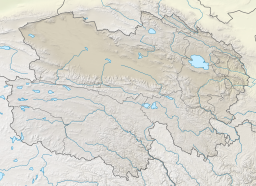ਦਾਬੁਸਨ ਝੀਲ
ਦਾਬੁਸੁਨ ਜਾਂ Dabuxun Lake, ਨੂੰ ਵਿਕਲਪਿਕ ਤੌਰ 'ਤੇ Dabasun Nor, ਉੱਤਰ-ਪੱਛਮੀ ਚੀਨ ਵਿੱਚ ਕਿੰਗਹਾਈ ਸੂਬੇ ਦੇ ਹੈਕਸੀ ਪ੍ਰੀਫੈਕਚਰ ਵਿੱਚ ਗੋਲਮੁਡ ਦੇ ਬਿਲਕੁਲ ਉੱਤਰ ਵਿੱਚ, ਕਰਹਾਨ ਕਸਬੇ ਦੇ ਕੋਲ ਇੱਕ ਝੀਲ ਹੈ। ਗੋਲਮੁਡ ਨਦੀ ਦੇ ਮੁੱਖ ਰਸਤੇ ਰਾਹੀਂ ਬਣਦੀ ਹੈ, ਇਹ ਕਰਹਾਨ ਪਲਾਯਾ ਦੀ ਸਭ ਤੋਂ ਵੱਡੀ ਮੌਜੂਦਾ ਝੀਲ ਹੈ।
| Dabusun Lake | |
|---|---|
 Dabusun Lake (2006)
| |
| Location | Golmud City Haixi Prefecture Qinghai Province China |
| Coordinates | 37°01′27″N 95°08′20″E / 37.024081°N 95.1389253°ECoordinates: 37°01′27″N 95°08′20″E / 37.024081°N 95.1389253°E |
| Type | Endorheic saline lake |
| Native name | |
| <span title="Primary inflows: rivers, streams, precipitation">Primary inflows</span> | Golmud River |
| Basin countries | China |
| Max. length | 30 km (19 mi) |
| Max. width | 4–7.5 km (2–5 mi) |
| Surface area | 184–334 km2 (71–129 sq mi) |
| Average depth | 0.5–1.02 m (1 ft 8 in – 3 ft 4 in) |
| Max. depth | 1.72 m (5 ft 8 in) |
| Surface elevation | 2,675 m (8,776 ft) |
| ਦਾਬੁਸਨ ਝੀਲ | |||||||||
|---|---|---|---|---|---|---|---|---|---|
 A map of Dabusun Lake in the central Qarhan Playa (1975) | |||||||||
| ਰਿਵਾਇਤੀ ਚੀਨੀ | 達布遜鹽湖 | ||||||||
| ਸਰਲ ਚੀਨੀ | 达布逊盐湖 | ||||||||
| Postal | Dabasun Nor | ||||||||
| Dabusun Salt Lake | |||||||||
| |||||||||
ਝੀਲ G3011 Liuge ਐਕਸਪ੍ਰੈਸਵੇਅ ਦੇ ਬਿਲਕੁਲ ਪੱਛਮ ਵਿੱਚ ਸਥਿਤ ਹੈ। ਇਹ ਕਿੰਗਜ਼ਾਂਗ ਰੇਲਵੇ 'ਤੇ ਦਾਬੂਸਨ ਅਤੇ ਕਰਹਾਨ ਰੇਲਵੇ ਸਟੇਸ਼ਨਾਂ ਵੀ ਪਹੁੰਚਿਆ ਜਾ ਸਕਦਾ ਹੈ।
ਨਾਮ
ਸੋਧੋਦਾਬੂਸੁਨ [1] ਜਾਂ ਦਾਬਾਸੁਨ ਨਾਰ [3] [4] ਇਸਦੇ ਮੰਗੋਲੀਆਈ ਨਾਮ ਦਾ ਰੋਮਨੀਕਰਨ ਹੈ, ਜਿਸਦਾ ਅਰਥ ਹੈ " ਸਾਲਟ ਲੇਕ "। [5] ਮੰਗੋਲੀਆਈ ਵਿੱਚ, ਨਾਮ ਨੂੰ ਕਈ ਵਾਰ "ਪੂਰਬੀ" ਨਾਮਿਤ ਕੀਤਾ ਜਾਂਦਾ ਹੈ, ਇਸ ਨੂੰ ਪੱਛਮੀ ਡਾਬੂਸਨ ਝੀਲ ਤੋਂ ਵੱਖਰਾ ਕਰਨ ਲਈ। [5] ਇਸ ਨੂੰ ਕਈ ਵਾਰ ਡੈਬਸਨ ਜਾਂ ਡੈਬਸਨ ਦੀ ਗਲਤ ਸਪੈਲਿੰਗ ਕੀਤੀ ਜਾਂਦੀ ਹੈ। [7] [8] ਇਸ ਨੂੰ ਪਹਿਲਾਂ ਦਲਾਈ ਦਾਬਾਸੁਨ ਦੇ ਨਾਂ ਨਾਲ ਜਾਣਿਆ ਜਾਂਦਾ ਸੀ, ਜਿਸਦਾ ਅਰਥ ਹੈ "ਸਮੁੰਦਰ" ਜਾਂ "ਲੂਣ ਦਾ ਸਮੁੰਦਰ"।
ਡੈਬੁਕਸੁਨ ਚੀਨੀ ਨਾਮ達布遜( Dábùxùn ) ਦਾ ਪਿਨਯਿਨ ਰੋਮਨੀਕਰਨ ਹੈ, ਜੋ ਮੰਗੋਲੀਆਈ ਨਾਮ ਦੇ ਅੱਖਰਾਂ ਵਿੱਚ ਇੱਕ ਪ੍ਰਤੀਲਿਪੀ ਹੈ ।
ਇਤਿਹਾਸ
ਸੋਧੋਇਹ ਵੀ ਵੇਖੋ
ਸੋਧੋਨੋਟਸ
ਸੋਧੋਹਵਾਲੇ
ਸੋਧੋਬਿਬਲੀਓਗ੍ਰਾਫੀ
ਸੋਧੋ
- "The Monthly Record", The Geographical Journal, 31 (4): 438–451, 1908, JSTOR 1777861.
- Casas, Enrique; et al. (1992), "Carnallite Mineralization in the Nonmarine, Qaidam Basin, China: Evidence for the Early Diagenetic Origin of Potash Evaporites", SEPM Journal of Sedimentary Research, 62 (5): 881–898, doi:10.1306/D4267A05-2B26-11D7-8648000102C1865D.
- Du, Yongsheng; et al. (2019), "Evaluation of boron isotopes in halite as an indicator of the salinity of Qarhan paleolake water in the eastern Qaidam Basin, western China", Geoscience Frontiers, 10: 253–262, Bibcode:2019AGUFM.V33C0255D, doi:10.1016/j.gsf.2018.02.016.
- Garrett, Donald Everett (1996), Potash: Deposits, Processing, Properties, and Uses, London: Chapman & Hall, ISBN 9789400915459.
- Jia Xiru (20 February 2019), "Qīnghǎi Měnggǔyǔ Dìmíng de Jǐge Tèsè 青海蒙古語地名的幾個特色 [Several Characteristics of Mongolian Placenames in Qinghai]", Xuěhuā Xīnwén 雪花新闻 [Snowflake News] (in ਚੀਨੀ), archived from the original on 15 ਨਵੰਬਰ 2019, retrieved 20 ਮਈ 2023.
- Dexin, J. (2000), "Quaternary Palynofloras and Paleoclimate of the Qaidam Basin, Qinghai Province, Northwestern China", Palynology, 24: 95–112, doi:10.2113/0240095.
- Qi, Huang; et al. (1997), "Stable isotopes distribution in core Ck6 and variations of paleoclimate over Qarhan Lake region in Qaidam Basin, China", Chinese Journal of Oceanology and Limnology, 15 (3): 271–278, Bibcode:1997ChJOL..15..271H, doi:10.1007/BF02850884, S2CID 129491899.
- Kong, Fanjing; et al. (2018), "Dalangtan Saline Playa in a Hyperarid Region on Tibet Plateau: I. Evolution and Environments", Astrobiology, 18 (10): 1243–1253, Bibcode:2018AsBio..18.1243K, doi:10.1089/ast.2018.1830, PMC 6205091, PMID 29792755.
- Lowenstein, Timothy K.; et al. (1994), "Major-Element and Stable-Isotope Geochemistry of Fluid Inclusions in Halite, Qaidam Basin, Western China: Implications for Late Pleistocene/Holocene Brine Evolution and Paleoclimates", in Rosen, Michael R. (ed.), Paleoclimate and Basin Evolution of Playa Systems, Special Paper, No. 289, Boulder: Geological Society of America, pp. 19–32, ISBN 9780813722894.
- Shan Zhiqiang (31 May 2010), "Qarhan Salt Lake: Drying Yard of the Heavens", Shanghai Daily.
- Spencer, Ronald James; et al. (1990), "Origin of Potash Salts and Brines in the Qaidam Basin, China" (PDF), Fluid-Mineral Interactions: A Tribute to H.P. Eugster, Special Publication No. 2, Geochemical Society.
- Stanford, Edward (1917), Complete Atlas of China, 2nd ed., London: China Inland Mission.
- Ward, Thomas (1878), "On 'The Salt Lakes, Deserts, and Salt Districts of Asia,' with a Map", Proceedings of the Literary and Philosophical Society of Liverpool during the Sixty-Seventh Session, 1877–78, vol. 32, Liverpool: D. Marples & Co, pp. 233–256.
- Yang, Hui; et al. (2012), "Integrated geophysical studies on the distribution of Quaternary biogenic gases in the Qaidam Basin, NW China", Petroleum Exploration and Development, 39 (1): 33–42, doi:10.1016/S1876-3804(12)60012-3.
- Yu, Ge; et al. (2001), Lake Status Records from China: Data Base Documentation (PDF), MPI-BGC Tech Rep, No. 4, Jena: Max Planck Institute for Biogeochemistry.
- Zhang Baozhen; et al. (1990), "Hydrogen and Oxygen Stable Isotope Analyses of Fluid Inclusions in Halite in Charhan Salt Lake with Geochemical Implications", Acta Sedimentologica Sinica, 8 (1): 3–17.
- Zheng Mianping (1997), An Introduction to Saline Lakes on the Qinghai–Tibet Plateau, Dordrecht: Kluwer Academic Publishers, ISBN 9789401154581.
- Zhou, S. L.; et al. (2016), "Spatial-temporal variations and their dynamics of the saline lakes in the Qaidam Basin over the past 40 years", IOP Conference Series: Earth and Environmental Science, 46 (1): 012043, Bibcode:2016E&ES...46a2043Z, doi:10.1088/1755-1315/46/1/012043.
